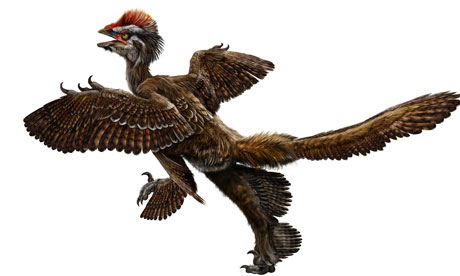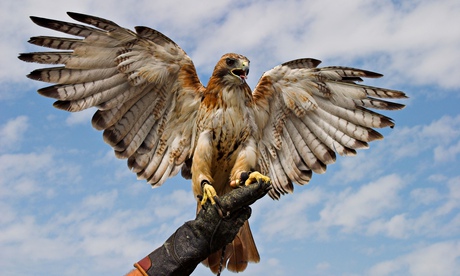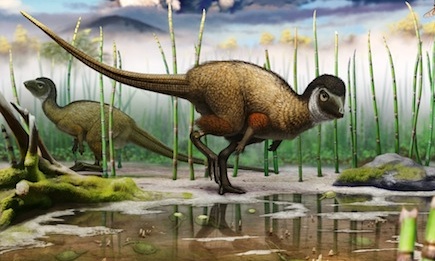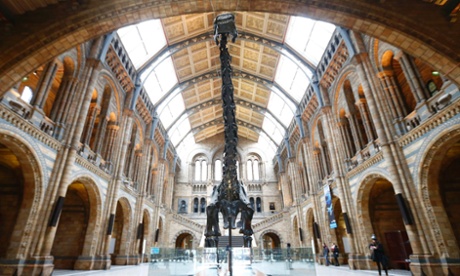Most of us have picked up a feather on a walk, taken it home, and marvelled at the sculpted brilliance of its structure – and then thought no more about it. But as Thor Hanson's book shows, bird feathers are so intricately constructed that modern technologists are now seriously trying to emulate their nanostructural perfection.
Hanson's study is a stroll through the many ramifications of feathers – their genesis, evolution, use in our duvets, use in mating displays, use as human adornment – but so amiably paced that no topic outstays its welcome. Indeed, at one point, fearing he might be in danger of becoming too technical, Hanson backs out charmingly: "I shut down the computer and turned my attention to something more familiar …"
Hanson is a young, independent conservation biologist, operating from an island northwest of Seattle. He is an engaging nature nut, the kind of guy who keeps dead roadkill in his freezer and is never happier than when yomping through the wild, interrogating all he sees. His enthusiasm is infectious and his subject so alluring that many science writers will be wondering: "Why didn't I think of that?"
Feathers are the most complicated artefact fashioned by nature from a single substance: the protein keratin. That's the stuff that nails, hair and horse's hooves are made from. But a hair is simply a string of dead protein fibres squeezed from the follicle, like glue from a nozzle. Bird feather keratin is similarly extruded from a follicle, but it is structured so that the barbs radiating from the central quill are held together by tiny Velcro-like fasteners. All this has to be cast in a single process. The principal gene involved in this magic turns out to be the same one that tells your eyes how far apart to be, and how to grow a thumb on one side and a little finger on the other: nature's master sculptor, whimsically named Sonic Hedgehog after the video game.
Feathers are at the heart of two of evolution's greatest mysteries: first, how could such an intricate structure have evolved and for what original purpose? And second, how did flight evolve? They are not the same question: bats fly, but they have no feathers. Great battles have been fought over these issues and Hanson recounts some of them, but in the last decade a series of fossil finds in China has helped clear up many of the mysteries. Feathers presents an easy way in to the standard model of bird and feather evolution.
Unlike human-engineered constructions, most things in nature have more than one function, and the mystery of how a complex organ can have evolved so perfectly fitted to its purpose is usually that it originally evolved for something else altogether and was later co-opted to a new function. Feathers have a suite of properties to make engineers drool: lightness, thermal insulation, strength and flexibility, water-repellency and advanced structuring giving rise to iridescence. The enormous whirlpool-patterned tail feathers of the male peacock have clearly evolved to their present form through sexual selection by peahens. But what was the function of feathers before they could develop such secondary characteristics? That's where the quarrels start.
The greatest glory of feathers lies in the dazzling iridescence they impart to many birds, most notably hummingbirds and birds of paradise. Darwin devoted four chapters to bird feathers in his investigation of sexual selection, The Descent of Man. Many male animals display to attract a mate. In feathers, birds have the best means available, and the mating displays of birds of paradise provided some of the most astonishing and memorable footage of all David Attenborough's programmes. What's good enough for birds is also good enough for humans, and feathers have been used in human status displays ever since the first iridescent feather was plucked from a bird. In the 19th century the demand for bird plumage for women's hats threatened the extinction of many species and led to the modern bird conservation movement.
In one chapter, Hanson goes to Las Vegas to check out the showgirls. One act features gorgeously top-heavy arrays of plumage mounted on top-heavy dancers, and Hanson uses this human adornment to make an important biological point. The costumes are as extravagant as is physically possible: "Not enough swish, and no one looks at you. Too much swish and your costume falls off," as one showgirl explains. Exactly the same problem is faced by the peacock, whose tail, if any larger, would be completely unsupportable.
Less sexy is the feather-down industry, but Hanson dives in here with equal enthusiasm, visiting Pacific Coast Feathers, in his home territory of Seattle. The supply of down for duvets and pillows depends on the duck and goose consumption patterns of East Asian peoples: the feathers are a by-product. Down still beats synthetics because technologists have as yet found no way of mimicking the intricate branching of feathers in their synthetic polymer media.
We go into the countryside, we read books like this, and we watch Attenborough for what the poet Louis MacNeice summed up as "the pleasure of dappled things, the beauty of adaptation to purpose, the glory of extravagance, classic elegance or romantic nonsense and grotesquerie". But there's more. As Hanson writes, birds and feathers are "at the heart of one of the hottest trends in the physical sciences": biomimetics.
The aviation industry, after a century of scorning anything to do with natural, flapping flight, is now very interested in the more subtle control a bird's conformable wing exerts compared to the clunky flaps of an airliner. Those upturned wingtips you see on many planes now are a crude but effective way of mimicking the way a falcon's wingtip feathers fan out to control the airflow more efficiently.
Next time you pick up a flight feather, look along its section: it will have a perfect aerofoil shape with the quill, the rachis, asymmetrically displaced to the front. This is exactly the section of an aeroplane wing. Each flight feather is a miniature wing, as perfect as any wind-tunnel-tested, computer-analysed, humanly-engineered structure.
• Peter Forbes's The Gecko's Foot: How Scientists are Taking a Leaf from Nature's Book is published by HarperPerennial.










